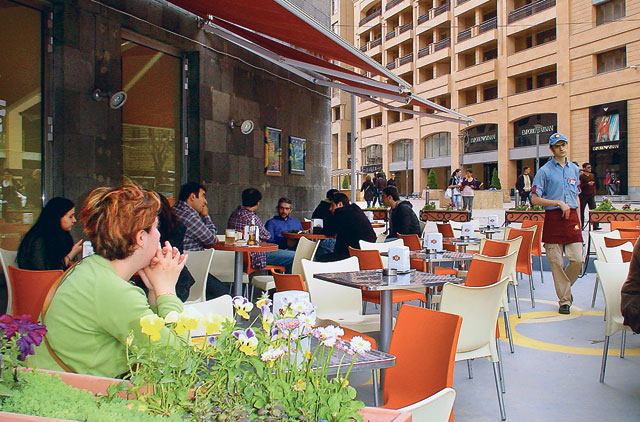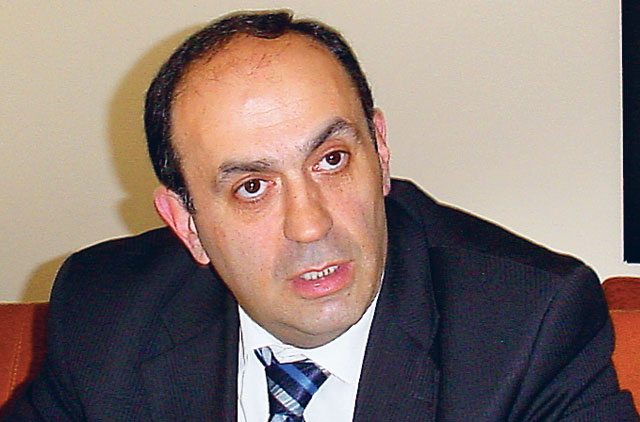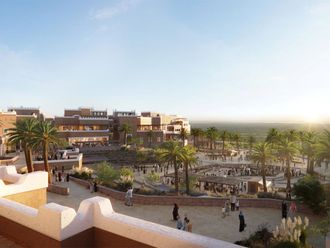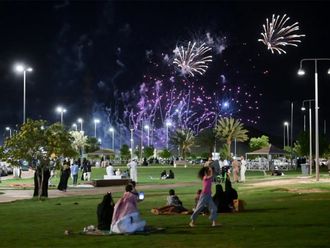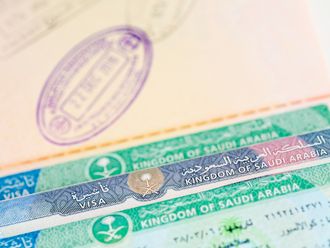
Yerevan: It has it all. Yet, much needs to be done.
Spectacular green landscapes and mountains covered by tall trees outside the city stretch as far as the horizon, while the decades-old Soviet-style utilitarian public buildings are among the main landmarks inside the Armenian capital.
The main streets named after prominent figures in the nearly 2,600-year-old city are now embracing new shops selling international brands. A few metres away, in the "old streets", there are shops selling local products and handicrafts.
Armenia, which got its independence only 19 years ago, is a promising tourist destination. It is also emerging as a place with great potential for tourism-related investment.
Nearly 575,000 tourists visited Armenia in 2009 compared to 45,000 in 2000.
Half of the steadily increasing number of tourists arriving in the former Soviet Union republic are Armenians living abroad. A considerable part of the remainder includes mainly those who have a "hunger for culture".
However, in order to attract more and more different types of tourists, including families and students, Armenian authorities are focusing on upgrading the infrastructure in the country — still influenced by the former Soviet era. For example, signs and names of different places are written in Russian, next to Armenian.
The young country also needs to market itself as a tourist destination internationally.
"What we are doing now is our homework to increase our standards," Armenian Deputy Minister of Economy and Minister of Tourism, Ara Bedrosyan, said.
"We understand that we still have to invest in infrastructure and in human resources because they both raise the tourism levels and create more demand on Armenia in the international markets," he told a group of visiting journalists from the UAE.
‘Huge achievements'
While the current tourism levels match "Armenia's capabilities", Bedrosyan explained, the country has had "huge achievements" between the early nineties and today.
In 1990, there were only three hotels involved in international tourism. Today, the number has jumped to 60.
While the airport was receiving mainly domestic flights, now up to 13 international airlines land at the newly-built port. (Construction has not yet been completed at Yerevan Airport.)
Officials added that there is a need, as well, to improve the road infrastructure in the country and raise them to international standards.
More investment to further upgrade restaurants and hotels are also needed, officials noted.
At present, tourism constitutes six per cent of the Gross Domestic Product (GDP). But the target is to increase it to 13 per cent by 2030.
The plan of action is a series of steps at different levels.
Some steps have already been implemented.
Commodities and accommodation prices were reduced as part of a general trend to lower costs. The cost of the entry visa was reduced from nearly $60 (Dh220) to $8.
Measures, furthermore, were introduced to ease the entry of people through the airport, the northern and southern borders — both eastern and western boundaries are closed due to border disputes with Azerbaijan and Turkey.
Negative impact
"Both the government and the private sector worked together on better marketing [of] the country as a tourist destination, and overcome the negative impact of the international financial crisis," added the minister, who was speaking through an interpreter.
Therefore, media, considered by Armenian officials as among the most important means of overcoming the impact of the international crisis which led to a decrease in tourism worldwide, was also utilised.
A 52-minute film on Armenia and its attractions was produced to high professional standards. Part of it was aired on international media.
Currently, many tourists travelling to Armenia include Iranians and Westerners. However, nearly "50 per cent of arriving tourists are Armenians living abroad, and they are coming to their country", Bedrosyan said.
This category of tourists, "usually bring their families with them in order to show them their original county and explain to them about their culture".
The other part of arriving tourists comprises "the type that is not coming to sit on the beaches. They arrive for cultural reasons", Bedrosyan said.
"They visit Armenia to satisfy their intellectual demands. They are categorised under historical and intellectual tourism."
Many of these tourists are "between 50 and 60 years old and they are doing well financially", the official said. Already there are churches listed under the World Heritage list: The cathedral and Churches of Echmiatsin and the archaeological site of Zvartnots, monasteries at Haghpat, Sanahin and Geghard and the Upper Azat Valley.
Yerevan also boasts opera houses and theatres.
The city prides itself on several streets named after prominent people past and present — Armenian artists, painters, musicians and writers. The national library in Armenia, established some 60 years ago, has more than 17,000 manuscripts and 2,230 books in many languages, primarily Armenian.
Mount Ararat, traditionally thought to be the landing place of Noah's Ark, is located along the border with Turkey, and can be seen from almost anywhere in the country of nearly 3 million people.
Tourists have different options, such as skiing in winter and hiking and picnicking at other times of the year. There are also attempts to promote and invest in the hot water spas in the country.
For instance, a Swiss company has shown interest in investing in Jermuk, an area famous for its nearly 500 hot springs, officials pointed out. The area, which is 175km from Yerevan, is surrounded by mountains and was famous during the Soviet era among thousands of tourists seeking cures for certain illnesses.
In order to encourage winter skiing, a new 200-room hotel was built in Kegharkunik, a northern governorate. Furnished hotel apartments are also in the area.
Kegharkunik, north of Yerevan, is located near Lake Sevan, the world's largest mountain lake.
Developing infrastructure
Several projects between Armenia and Western countries, including Germany, France, Australia, Canada and the US are under way to develop the infrastructure in the area, including building a teleferic (cable car) and hotels in the very cold area.
Other countries have shown interest in investing in mining gold ore in the region, as well as basalt stones famous in the area.
"There are huge amounts of basalt stones, but there are no buyers," Never Boghosian, Kegharkunik's mayor said.
"Even if we want to export, transportation will be a problem," he added, referring to the closed eastern and western borders.
Since air and land freight could be costly and unprofitable, shipping by train seems to be the only available means.
The governorate, which is 2,000 metres above sea level and has a population of nearly a quarter of a million, is also known for its honey, dairy products, cherries and apricots.
"Also, every year we have a problem with our production of potatoes," Boghosian said.
The production far exceeds domestic need. As a result, the extra produce is sold at cost price in view of the difficulties in exporting due to closed borders with both Turkey and Azerbaijan.
"In order to establish a potato chips factory, we need investment," Boghosian said.
Nearly half of Armenia's potato supply comes from Kegharkunik, which produces nearly 300,000 tonnes yearly, as well as nearly 110,000 to 115,000 tonnes of wheat a year.
"Armenia's investment regulations are very flexible, and the taxes are very appropriate" the mayor said, trying to encourage more investors to go to the area.
In terms of tourism, many Armenians say that their country is not even "fully discovered".
"The most important thing they can do here is picnicking in the forest. There are also hot springs," said Armen Santrosyan, mayor of Dilijan, a city in the heart of an awesome green area squeezed between high mountains.
Most of the 17,000 population of the city work in tourism.
Cultural city
During the Soviet era, the city was of some importance, officials said,
That time, there were nearly five hotels run only by Moscow, and "they would send anybody who needed recreation and treatment to one of these hotels", Santrosyan recalled.
Today, there are nearly 20 hotels, resorts and furnished apartments in Dilijan, known as the "cultural city" for the different schools it has, including an international school for children, two music schools and two sports centres.
Some of the places in the city, located about 90km northeast of Yerevan and 50km west of Azerbaijan, give Armenian tourists from inside the country or the diaspora, priority over non-Armenian tourists during the extremely busy but pleasant summer months.
Many non-Armenian tourists come from European countries and the US, and the peak is usually the period between May and October. In the summer season, all the 1,300 beds available are fully occupied. In late April, only up to 20 per cent occupancy is usually recorded.
"We understand that being a landlocked country and a small country, our success comes from being part of a regional product," Bedrosyan said.
"What we are doing is very successful with Iran and neighbouring Georgia within this project of the Great Silk Road, the caravan trade routes that linked Eastern and Western civilisation in ancient and middle ages."
Tourism along the route of the Great Silk Road, which was first operated as a route between China and the capital of the Roman Empire in the 2nd century BC, is gaining momentum with the attention of the World Tourism Organisation (WTO)."
The WTO is implementing a long-term tourist project aimed at promoting tourism in the region.


